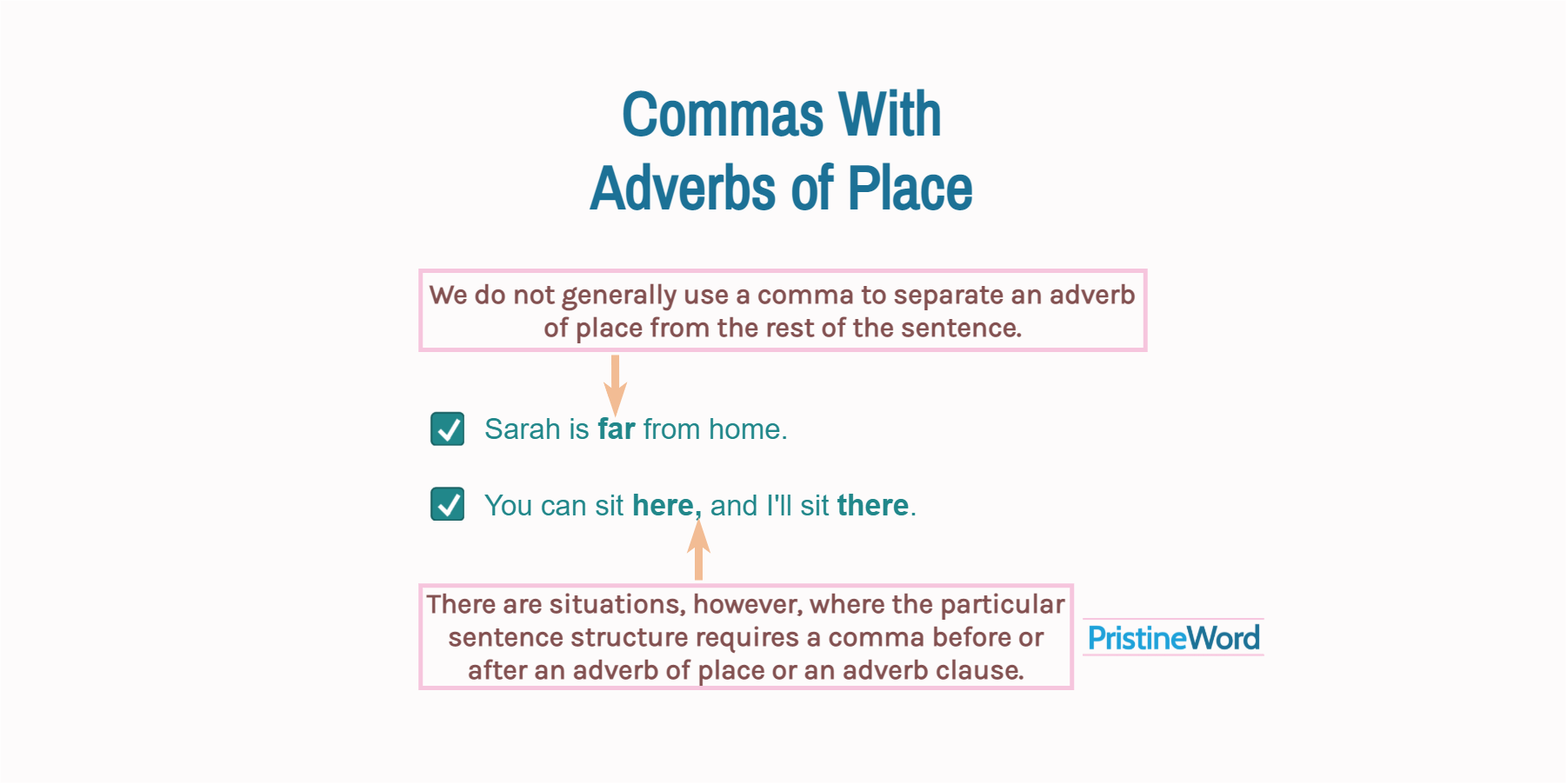We do not generally use a comma to separate an adverb of place from the rest of the sentence. There are situations, however, where the particular sentence structure requires a comma before or after an adverb of place or an adverb clause.
We do not generally use a comma to separate an adverb of place from the rest of the sentence.
Sarah is far from home.
There are situations, however, where the particular sentence structure requires a comma before or after an adverb of place or an adverb clause.
You can sit here, and I'll sit there.
Contents
1. Quick Review of Adverbs of Place
An adverb of place typically modifies a verb to tell us where something happens or indicate a position.
The mall is far.
She now lives on the island with her husband.
"Here" and "there" are probably the most common adverbs of place. They can go at the beginning or at the end of a sentence or clause.
My coat is there.
Where is the book? Here it is!
Adverbs of place can express movement (e.g., off, down, over, in, away). They normally go after the verb.
Robert is moving away next month. He is going to Canada.
Olivia is getting off the bus.
They can also indicate the direction of a movement (e.g., backward, forward, upwards, east, north).
Emma stretched her arms upwards and inhaled.
Bend forward with your feet planted wide.
Adverbs of place can refer to unspecified locations (e.g., somewhere, anywhere, everywhere).
I couldn't find my keys anywhere.
There are mosquitoes everywhere.
You can also use an adverb of place to describe a place or position—a phrase is just a group of words without a subject-verb component.
There is a grocery store around the corner.
This area was once under the sea.
2. When to Avoid Commas With Adverbs of Place
Generally, we do not place a comma to separate an adverb of place from the verb it modifies.
My sister Sarah is there.
Peter went upstairs to his room.
Similarly, we do not typically use commas to separate an adverbial phrase of place from the rest of the sentence.
The keys are in the box.
They moved to another country.
But there are particular situations where you may have to use commas.
3. When to Use a Comma Before or After an Adverb of Place
You may need a comma before or after an adverb of place with certain sentence structures, for example, when using:
- Introductory phrases
- Locations and addresses
- Parenthetical expressions
- Independent clauses with a connector
- Interjections
- Adverb clauses
3.1 Introductory phrases
We can use an adverbial phrase of place to introduce a new sentence or clause. In such a situation, the comma is optional if the introductory phrase is brief (less than three or four words).
Under the arch she kissed me on the neck. (short introductory phrase)
But add a comma after longer introductory phrases or to avoid confusion.
Under the shade of an old pine tree, we shared a passionate kiss. (long introductory phrase)
3.2 Commas in locations and addresses
Use commas to separate the different elements of a location (street address, city, and state).
We moved to Chicago, Illinois.
Her office is located at 139 5th Street, San Francisco, California.
If you are using just one element (e.g., the state or the street), no comma is necessary.
Elderly support services in Florida can be found on our website.
3.3 Parenthetical expressions
A parenthetical expression is a group of words that add extra information without changing the meaning of a sentence. Parenthetical expressions should be surrounded by commas.
The children are playing, out in the street, with their mother.
The phrase "out in the street" gives us nonessential information. The significant meaning of the sentence is "The children are playing with their mother."
Note also that without the phrase "with their mother", "out in the street" would become essential, so no comma in this case.
The children were playing out in the street.
The children were playing, out in the street.
3.4 Joining two independent clauses with a connector
You should also put a comma if the adverb of place is followed by a connector (such as "and", "or", "but", etc.) and followed by an independent clause.
I'll sit there, and you can sit here.
Recommended: Comma with "and"
3.5 Interjections before an adverb of place
Interjections can be followed by a comma or an exclamation point. For example:
Where is my coat? Ah, here it is!
3.6 Adverb Clauses
An adverbial subordinate clause (also called adverb clause) is a dependent clause functioning as an adverb.
Wherever Peter goes, he gets into trouble.
When starting a sentence with a dependent clause, insert a comma after it.
Wherever Olivia goes, she bumps into people she knows.
But the comma is unnecessary if the dependent clause follows the independent clause.
I'm not sure where they live.
Recommended: Commas with subordinating conjunctions

